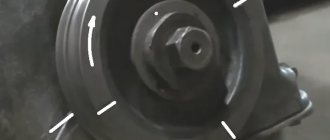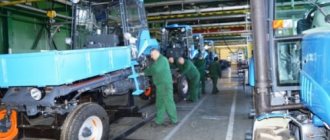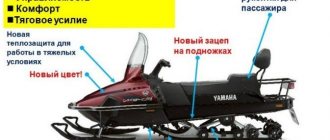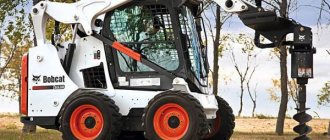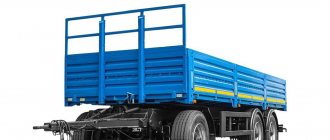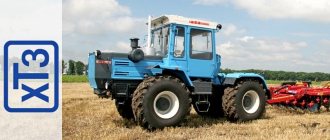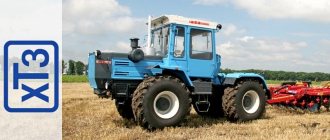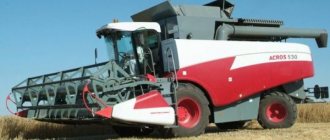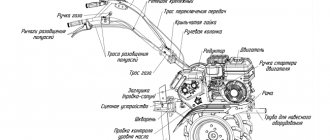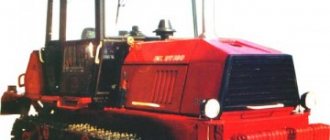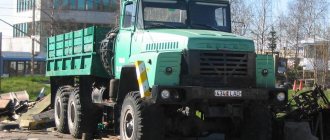General information and areas of application of "D-260"
The six cylinders of the MMZ D-260 engine are placed vertically in an in-line arrangement. The direction of rotation of the crankshaft is right (clockwise). The engine is four-stroke, equipped with direct fuel injection, liquid cooling, a turbocharging system and intercooling of charge air. Certified according to GOST-17.2.2.02, GOST-17.2.2.05, OST-23.3.23 and GOST-2000.
Depending on their purpose, diesel engines of this brand can be equipped with the following additional assembly units: a pneumatic compressor, a gear power steering pump with a drive, and clutch disc assemblies. When installed on a tractor, the MTZ “D-260” is equipped with a water radiator, electrical equipment and control devices.
"D-260" "under the hood" of the Belarus MTZ-1221 tractor.
In addition to the energy-rich wheeled tractors of the Minsk Tractor Plant, MMZ D-260 engines also power various Belarusian and Russian grain and forage harvesters, loaders, road construction equipment, pumping and diesel generator sets.
About the history of the enterprise and the MMZ D-260 engine
The history of the Minsk Motor Plant is closely connected with the history of another glorious Belarusian enterprise - the Minsk Tractor Plant. Built immediately after the Great Patriotic War, MTZ rapidly developed and increased its production. In 1960, a decision was made to build a plant for the production of diesel engines in Minsk. First of all, for the new model of the MTZ-50 tractor, in the amount of 120 thousand D-50 engines per year.
The Minsk Motor Plant was built in just over two years, on the north-eastern outskirts of Minsk between the tractor and bearing factories. Serial production of D-50 motors started at the enterprise in July 1963. Starting next year, all MTZ Belarus tractors began to be equipped with Minsk-made engines.
The first in the history of the enterprise, not a four-, but a six-cylinder diesel engine - “MMZ D-260” - was designed and built in the first half of the 90s of the twentieth century. And its mass serial production was launched in 1995. In addition to MTZ, such powerful enterprises as the Minsk Automobile Plant, the largest, Gomselmash, became consumers of these products; road construction equipment, compressor stations, etc. In 2006, the 50,000th anniversary MMZ D-260 engine rolled off the plant’s assembly line, which went to the Minsk manufacturer of road construction equipment -.
Alexander Lukashenko is a frequent guest at Belarusian enterprises, including MMZ.
In total, the list of MMZ partner enterprises, which are consumers of its products, includes 44 factories and firms. Most of them, of course, are in Russia and Belarus; Ukraine, Uzbekistan, Kazakhstan and Poland are also represented.
Technical characteristics of the “D-260” in numbers and a list of its modifications
- Working volume – 7.12 liters;
- Cylinder diameter – 110 mm, Piston stroke – 125 mm;
- The operating order of the cylinders is 1-5-3-6-2-4;
- Rated power - 114 kW (155 hp);
- Rated rotation speed – 2100 rpm;
- Idle speed - from 850 (min) to 2260 (max);
- Maximum torque – 622 N.m (63.4 kgf.m);
- Rotation speed at maximum torque – 1400 rpm;
- Compression ratio – 16;
- Specific fuel consumption – 220 g/kWh (162 g/l.h.);
- Engine weight – 710 kilograms;
- Overall dimensions - 1300x705x1118 mm.
Currently, the price list on the official website of the Minsk Motor Plant presents to the attention of potential consumers fourteen modifications of the D-260 diesel engine. Namely: “D260.1-305”, “D260.1S2-333”, “D260.1S-394”, “D260.1-305”, “D260.1-306”, “D260.1-308” , "D260.1-339", "D260.1-358", "D260.1-372", "D260.1-380", "D260.1-406", "D260.1-407", " D260.1-417", "D260.1-443".
MMZ D-260 engines are equipped with starters 3002.3708 (24V), generators G9945.3701-1 (28V), turbochargers TKR-7-00.01 (BZA, Borisov, Belarus), high-pressure fuel pumps PP6M10P1f-3491" ("Motorpal", Jihlava, Czech Republic), or "YAZDA 363.1111005-40" (Yaroslavl), water pumps "260-1307116-A", oil pumps "260-1011020".
Description of the motor
The design of the D 260 engine provides for the presence of six chambers lined up in a row and performing four strokes per cycle. The material of the installation frame is cast iron, into which “wet” sleeves are pressed. For a greater cooling effect, oil sprayers are used to direct the liquid to the bottom of the displacers. The crankshaft is made of steel, placed in the engine frame, the main and connecting rod journals of the product are 85.25 and 73 mm, respectively. The stroke of the displacer under such conditions is 125 mm, the displacer with a cross section of 110 mm is made of aluminum, the connecting rods are steel.
Power plant with a volume of 7.12 liters. The head of the frame is made of cast iron; seats are inserted inside the product to serve 12 valves. The engine camshaft is located inside the frame; force is transmitted to the valves through a pusher, rod and rocker arm. There are two valves per chamber - inlet and outlet, with a cross section of 48 and 42 mm, respectively. During a routine inspection, the degree of wear is monitored; after exceeding the permissible level, the products are adjusted.
To power the engine, a “363” pump from the Yaroslavl Diesel Equipment Plant is used. A TKR 7 turbine compressor is also installed. To comply with constantly changing environmental standards, the engine also has to be modified. The first development was carried out in 1998, then the device began to comply with Euro-1 requirements. A series of further improvements occurred in 2001 and 2005, when the engine was brought to Euro 2 and 3, respectively. In the latter case, in order to achieve the result, Common rail injection was used together with a fuel pump and Bosch electronic control.
Design and basic parts of MMZ D-260
Cylinder block of the D-260 engine
The cylinder block of the D-260 engine is the main body part, made in the form of a monoblock, which is a rigid casting of cast iron. The block bores contain six removable sleeves made from a special grade of cast iron.
Each liner is mounted in the cylinder block along two centering belts. In the upper belt the liner is secured with a collar, and in the lower belt it is sealed with two rubber rings placed in the grooves of the cylinder block. Coolant circulates between the walls of the MMZ D-260 cylinder block and the liners. There are special bosses on the transverse partitions of the cylinder block, which are intended to form supports for the crankshaft. Covers are installed on these tides. The bosses together with the covers form places for installing the main bearings. The beds for the main bearing shells are bored in one installation, complete with covers. These covers cannot be swapped.
Multifunctional loader "Amkodor 332S4" with a "D-260" engine.
The MMZ D-260 cylinder block is equipped with a longitudinal oil channel, from which oil is transported through transverse channels to the crankshaft main bearings, and then to the camshaft journals and to the injectors, cooling the pistons. Piston cooling nozzles are installed in the upper part of the cylinder block, in the second, fourth and sixth crankshaft bearings. On the water distribution channel of the cylinder block there is a platform for mounting a liquid-oil heat exchanger. The supply and removal of oil from the heat exchanger is carried out through channels in the block.
To increase rigidity, the lower plane of the cylinder block is shifted downward by 80 millimeters, relative to the crankshaft axis. A steel distribution board and distribution cover are attached to the front end of the block, and a sheet of steel is attached to the rear end, through which the power unit is connected to the frame of the tractor or combine. 2 brackets, which are located on the side surfaces of the cylinder block, are also the front engine support. The bottom of the cylinder block is covered with an oil sump.
Heads in the cylinder block of the D-260 engine
The MMZ D-260 cylinder heads are cast from cast iron and are interchangeable (one head fits three cylinders). The internal cavities of these cylinder heads are equipped with inlet and outlet channels, which are closed by valves.
To ensure heat dissipation, the cylinder heads are equipped with internal cavities in which coolant circulates. The cylinder heads have plug-in valve seats. They consist of a special heat-resistant and wear-resistant alloy.
"D-260" on the next modification of the "T-150" tractor.
Three injectors are installed on each cylinder head. Also mounted here are the rocker arm axles and the rocker arms themselves, struts, head covers with caps covering the valve mechanism. To seal the connector between the heads and the cylinder block, a gasket made of asbestos-free fabric is provided. The holes for the cylinder liners and the oil channel are edged with sheet steel. Additional edging of the cylinder holes of the gasket with fluoroplastic rings is carried out during the engine assembly process.
Engine crank mechanism
The engine crank mechanism includes: a crankshaft with main and connecting rod bearings, a flywheel, pistons with piston rings and pins, connecting rods. The crankshaft “D-260” is made of steel; it has 7 main journals and 6 connecting rod journals. To compensate for the loads on the bearings from inertial forces, removable counterweights are installed on the first, sixth, seventh and twelfth cheeks of the crankshaft. Cavities are made in the connecting rod journals for additional centrifugal oil purification. The cavities of the necks are covered with threaded plugs.
Four bimetallic (steel-aluminum) half rings installed in the bores of the cylinder block and the cover of the fourth main bearing absorb the axial force of the D-260 crankshaft. The engine crankshaft is sealed with cuffs on the front and rear sides.
The following are installed on the front edge of the shaft: with interference – the timing gear (crankshaft gear) and the oil pump drive gear; drive pulley for a water pump, generator, air conditioning compressor (if we are talking about the energy-rich MTZ-1221 tractor). In order to reduce the level of torsional vibrations of the crankshaft, a silicone damper is mounted on the pulley hub.
The pistons of the MMZ D-260 engine are made of aluminum alloy. A combustion chamber is provided at the bottom of the piston. In the upper part of the pistons there are 3 grooves - compression rings are installed in the first 2 of them, and an oil scraper ring with an expander is installed in the 3rd. The hollow piston pins are made of chrome-nickel steel. The movement of the fingers along the axis in the piston bosses is limited by special retaining rings.
The connecting rod of the D-260 engine is made of steel, I-section. The bushing is pressed into its upper head. The piston pins are lubricated through special holes in the bushing and the upper head of the connecting rod. Boring of the lower head of the connecting rod for the bearings is carried out together with the cover. The connecting rod and the cap have the same numbers stamped on their surfaces. The connecting rod caps are not interchangeable.
There are also certain weight groups of connecting rods, based on the mass of their lower and upper heads. And the engine must be equipped with connecting rods of an identical weight group. Thin-walled liners for the connecting rod and main bearings of the crankshaft are made from a bimetallic strip. According to their inner diameter, the liners are made in two sizes, identical to the crankshaft journals.
The flywheel is made of cast iron and is bolted to the crankshaft flange. Steel gear rims are pressed onto the D-260 flywheels.
Gas distribution mechanism of the D-260 engine
The gas distribution mechanism of the MMZ D-260 diesel engine consists of gears, a camshaft, intake and exhaust valves, as well as parts for their installation and drive: pushers, rods, rocker arms, adjusting screws with nuts, plates, crackers, springs, struts and rocker arm axles.
The camshaft here is 4-bearing; it receives rotation from the crankshaft through distribution gears. The pushers are made of steel, with spherical bottoms, coated with special cast iron. The camshaft cams are made with a certain slope, due to which the pushers make rotational movements during operation.
Combine harvester "Polesie" with engine "D-260.4"
The push rods are made of steel rods. The spherical part that fits inside the pusher and the rod cup are hardened. The valve rocker arms are made of steel, they swing on an axis that is installed in the racks. The rocker arm axles are hollow, having 6 radial holes for lubrication of the rocker arms. The movement of the rocker arms along the axis is limited by special spacer springs.
The intake and exhaust valves on the D-260 are made of heat-resistant steel. They make movements in guide bushings that are pressed into the cylinder heads. Each valve can close under the influence of 2 springs (internal and external), fixed to its rod by means of a plate and crackers.
The valve guides are equipped with sealing collars that prevent oil from entering the diesel engine cylinders through the gaps between the valve stems and the guides. In the crankcase, which is formed by the distribution plate on the cylinder block and the distribution cover, there are distribution gears.
Power system "D-260"
The power supply system (fuel) of the D-260 diesel engine includes a fuel pump, injectors, low and high pressure pipelines, an air cleaner, intake and exhaust manifolds, a turbocharger, coarse and fine fuel filters, and a fuel tank.
MMZ D-260 diesel engines use in-line high-pressure fuel pumps (HPFP) produced by YaZDA OJSC, Yaroslavl, or Czech Motorpal. The fuel injection pump of the D-260 engine has 6 sections and performs the function of supplying strictly dosed portions of diesel fuel into the working cavities of the cylinders, for a certain time and under high pressure. The injection pump is activated from the crankshaft, through the timing gears of the D-260 diesel engine and the drive half-coupling mounted on the cam shaft.
A fuel priming pump and a rotation regulator with a boost corrector are combined into a single unit with an injection pump. The fuel priming pump is located on the high pressure pump housing. It supplies fuel from the tank to the injection pump and is driven by the eccentric of the cam shaft.
Fuel pump "YAZDA 363.1111005-40" for "D-260".
In order to remove air from the power supply system, a piston-type manual pump is mounted on the fuel injection pump. To ensure reliable and stable engine starting, the regulator is equipped with a starting device to ensure increased supply of diesel fuel during engine starting.
A bypass valve is installed in the fuel pump head, which serves to create the required pressure - 0.12...0.19 MPa, in the low pressure channels of the fuel pump. The excess volume of fuel supplied by the fuel pump is directed through the bypass valve to be drained into the tank. When the engine is not running, the bypass valve is needed to ensure the tightness of the low-pressure cavity of the pump, which is absolutely necessary for reliable starting of the engine. The fuel pump parts are lubricated with oil from the diesel lubrication system.
The injectors that are used in the D-260 for injecting diesel fuel into the cylinders are with a closed-type five-hole nozzle. These injectors provide the necessary uniform spray of fuel under significant pressure. In order to increase the reliability of the atomizer and to ensure the stability of its parameters, a gasket-screen made of a steel cage and fluoroplastic is installed under the nozzle.
The coarse fuel filter of the D-260 engine carries out preliminary cleaning of the fuel from any mechanical impurities and water. Its components are a body, a diffuser, a reflector with a mesh, and a glass with a damper. A fine fuel filter is necessary for the final purification of diesel fuel. It is equipped with a replaceable paper element. Diesel fuel, flowing through the curtains of this paper filter element, is finally cleaned of even small and minute mechanical impurities.
At the bottom of the filter housing there is a hole with a plug for draining sediment. There is also a special plug on the filter cover to remove air from the engine power system. The air sucked into the working cavities of the cylinders is cleaned by a special filter element made of paper filter cartridges, which are made of special porous cardboard. The air purifier has 3 cleaning stages. The first is a monocyclone, and the 2nd and 3rd are the main and control paper filter cartridges.
The air, under the influence of vacuum created by the turbocharger of the MMZ D-260 engine, passes through the air cleaner, cleared of dust and then entering the discharge part of the turbocharger. From there it is supplied under pressure to the engine cylinders.
Turbocharger of diesel engine "MMZ D-260"
The D-260 diesel engine uses a turbocharger that uses the energy of exhaust gases to additionally pressurize air into the diesel cylinders. Exhaust gases from the diesel cylinders are pumped under pressure through the exhaust manifold into the turbine scroll channels and rotate the turbine wheel and shaft. The D-260 turbocharger is designed according to the following scheme: a radial centripetal turbine and a centrifugal single-stage compressor.
MMZ often takes part in agricultural exhibitions and fairs in the CIS.
Engine cooling system "D-260"
The cooling system of the MMZ D-260 engine uses the principles of a closed type and forced circulation of coolant from a centrifugal pump. The rotation of the water pump is carried out using a V-belt from the crankshaft pulley. The temperature of the coolant in the system is controlled by a remote thermometer and a light indicator.
To warm up the engine faster after starting and automatically adjust the temperature at various loads, 2 “TS-107” thermostats are used, which are installed in the discharge line. Water pumps on MMZ D-260 engines are installed complete with a fan attached to a pulley.
Reviews about the MMZ D-260 engine
There are few reviews about the specific practical application of the D-260 engines, and they are very ambiguous. Since this engine performs well as a power unit for energy-saturated tractors and road-building equipment, it is not very suitable for use on heavy-duty “long-range” trucks.
The President of Belarus is presented with a model of the engine during his visit to MMZ.
In this area, it is inferior to the traditional YaMZ-236 and has not received serious distribution (except for “single” (without a trailer) MAZs for the domestic Belarusian market). Despite the fact that the MMZ D-260 costs less than the YaMZ-236.
Oil change
Changing the oil and oil filter is carried out quite typically for all models of MMZ power units marked D. The process itself is not particularly different from other diesel engines. Let's consider the main aspects of maintenance.
General view of the D-260 engine
- Unscrew the drain plug on the oil pan. Do not forget to install a container where the liquid will be drained.
- After the oil has drained, you need to tighten the drain plug.
- We change the fine and coarse oil filters.
- Fill in new engine lubricant.
- After warming up, you need to check the lubricant level in the engine. If necessary, fill in the missing amount.
Price of the MMZ D-260 engine
The price of the new D-260 engine starts at 430,000 rubles. First (as the price increases) in the list are modifications intended for electrical units and road cars; then, more expensive - for the MTZ-1221 and MTZ-1523 tractors; further – for motor graders, pumping units, Polesie KZS-7 and Niva Effect combines. These modifications cost 480,000 rubles in the official price list. There are also offers for the sale of D-260 engines after major overhauls. Prices for such motors start at 150 thousand rubles.
Features of in-line and overhaul repairs
Repairing the D-260 engine is a whole range of operations to restore the engine’s performance, which is not recommended to be done with your own hands. So, it’s worth turning to professionals who can correctly diagnose faults and wear, as well as which internal element needs to be replaced.
D260 engine after major overhaul
Let's consider the main set of operations that are carried out for the D-260 engine in order to carry out a major overhaul of the engine:
- Superficial diagnostics of faults is carried out by ear. The mechanic determines the presence of extraneous noise, as well as the preliminary location.
- Removing the engine from the car, as well as completely disassembling the power unit.
- Measurements of cylinders and crankshaft. Determining the repair number, as well as ordering spare parts. As practice shows, in most cases, in order not to bore the engine cylinders, the block is sleeved. This parameter allows, in case of subsequent repairs, to bore not the block, but the sleeves, which, when worn, can be removed and new ones inserted.
- Cylinder head repair.
- Assembly of the power unit.
High pressure fuel pump from D260 engine
A separate parameter is the restoration of the injection pump. As practice shows, the technician repairs only the plunger pair, which wears out most often.
As for on-line repair operations, every owner of a car with a D260 engine has sufficient skills and knowledge to restore their engine themselves, the main thing is that the hand grows from the right place. The most common problems include:
- Starter and generator malfunction.
- Failure of the water pump.
- Replacing drive belts.
- Adjusting the valve mechanism.
- Change of oil.
- Replacing engine filters.
In-line repair of the D260 engine
Repair instructions for each unit are available on the Internet or you can use factory books that are publicly available.
